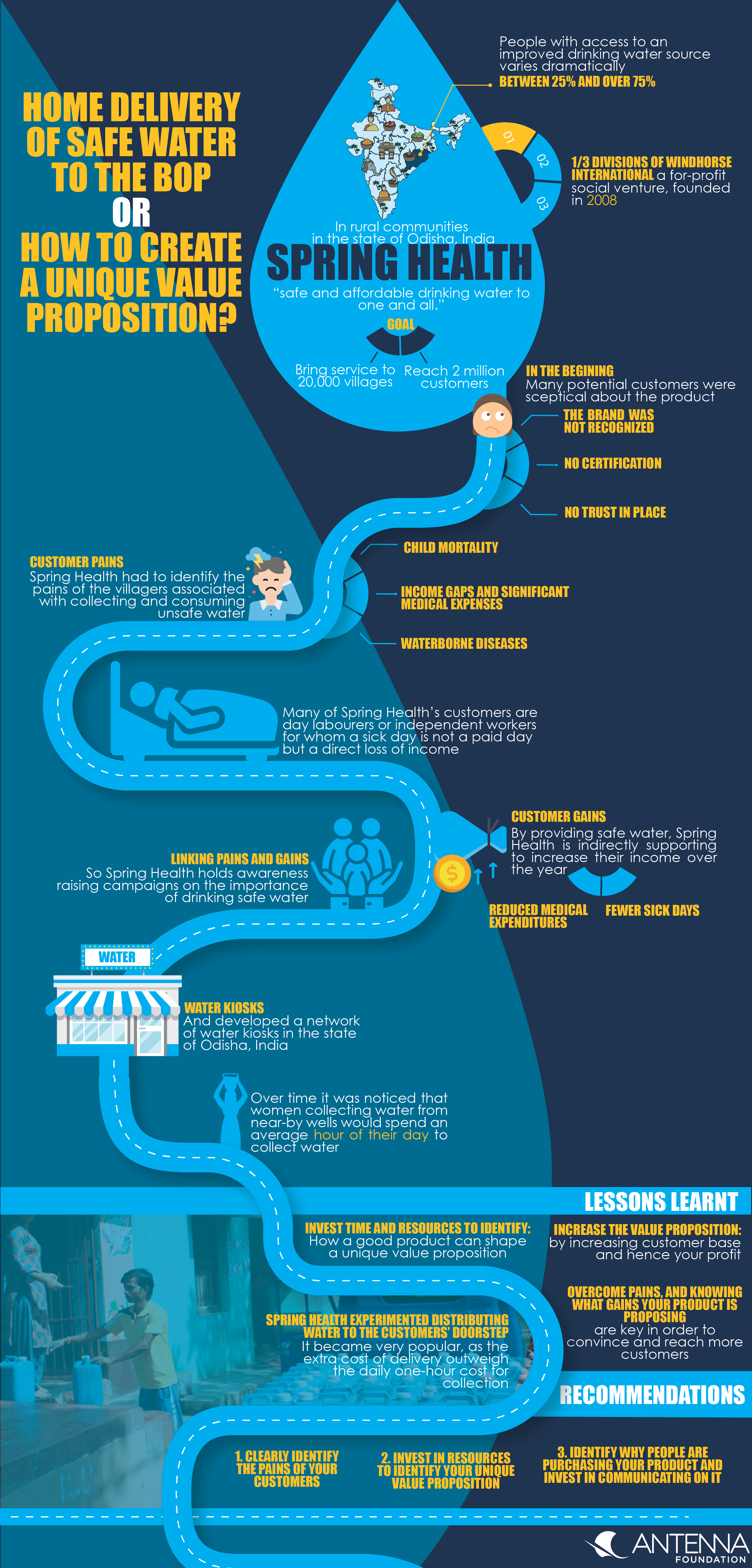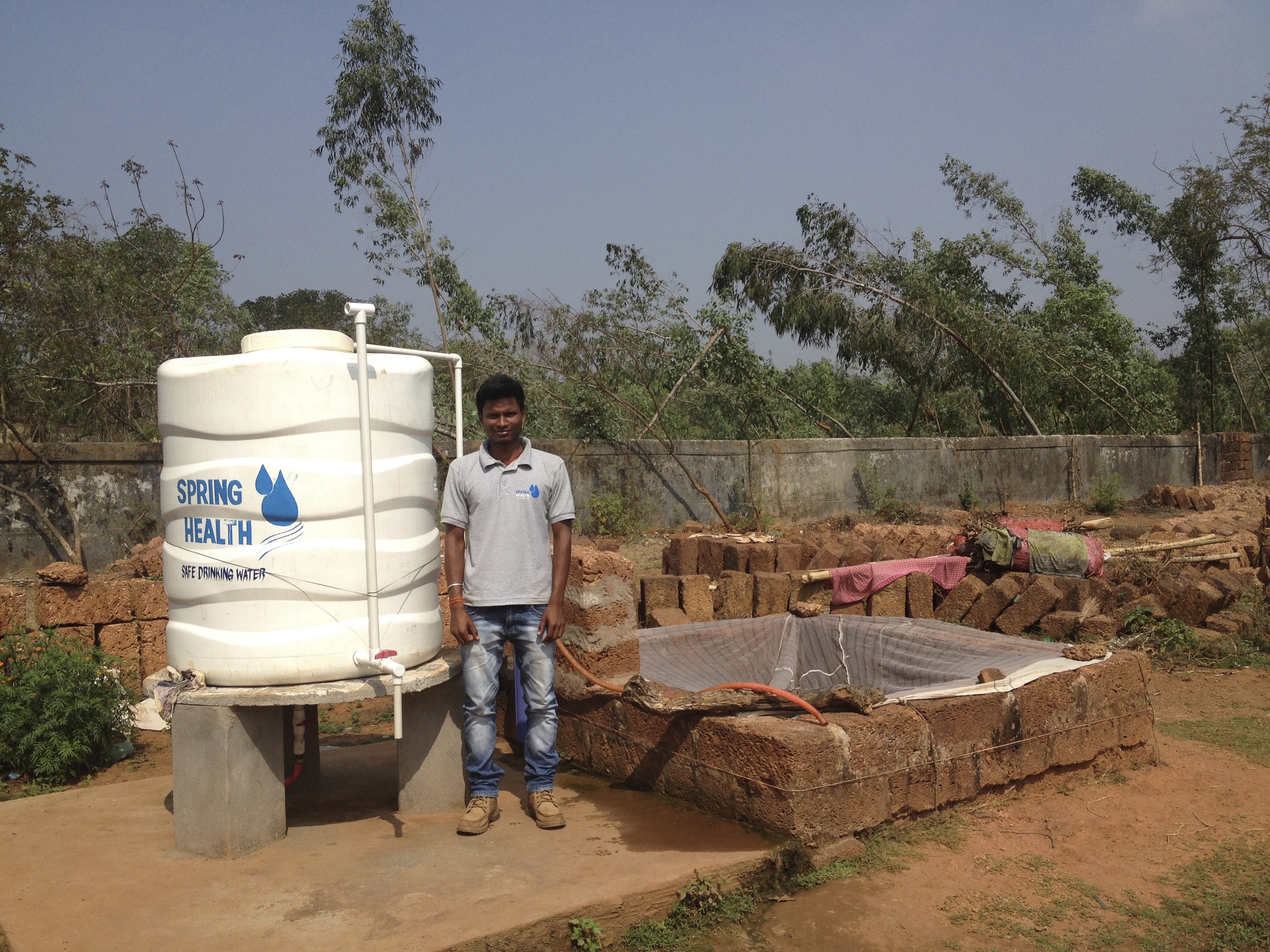
This case study about Spring Health supports and illustrates the theoretic factsheet "Risk management for safe water enterprises" with practical insights.
Spring Health is the first of three divisions of Windhorse International, a for-profit social venture firm founded in 2008 by social innovator Paul Polak. The hope of the founders was that Spring Health would demonstrate that social enterprises could bring essential services like safe water to the poorest people of the bottom of the economic pyramid (BoP) on a large scale. Spring Health has the long-term goal to bring its service to 20,000 villages across India and reach 2 million unique customers.
Spring Health is operating a network of water kiosks, based on a micro-entrepreneur sales model (see also case study value creation for more detailed information) and offers daily delivery of 10 litre jerry cans of safe drinking water to the homes of people in rural communities in the state of Odisha, India. People in Odisha have traditionally been underserved by public and private water service providers, which led to widespread problems of both water quality and quantity. Irregular weather patterns, potentially linked to climate change, have exacerbated these issues in recent years. Naturally occurring chemicals in the groundwater, especially fluoride and iron, and total dissolved solids pose water safety and acceptability issues in many districts across the state. Also have intensive mining activities made certain groundwater so polluted that they are “toxic as far as the groundwater potability is concerned” (DHAKATE & SINGH, 2008).

Since its inception in 2008 Spring Health had promising and increasing sales, which sharply dropped in spring 2016 due to a severe drought that hit Odisha and the rest of India alike from April to June 2016. This drought dried up 54 of Spring Health’s wells (see picture above), roughly 20 % of the company’s water supply. Spring Health attempted to supply the customers in the water scarce villages with water from nearby water kiosks but was unable to fully meet supply, leading to a large drop in customers and sales. This costed Spring Health over a year of growth, taking the company back to January 2015 levels. The drought ended in July, allowing Spring Health to recover sales and customers gradually but was struck by another drought in early November 2016. Based on these circumstances combined with the drastic drops in sales jeopardising the company’s existence, Spring Health’s management was triggered to develop and execute a clear risk management strategy.
In order to mitigate the risk of dried out wells Spring Health considered different steps to reduce the company’s exposure to droughts and water shortages. Deepening wells and installing boreholes in certain villages, as well as exploring the installation of rain-water collection systems were under consideration. After assessing these options, the management decided that the most promising solution is in expanding its access to wells that currently have not been under consideration due to chemical contamination. In spring 2017 a pilot project with a solar operated chlorine dioxide device started in order to treat water from wells with chemical contamination (AFFWS, 2017). This would allow Spring Health to source water from wells that previously could not be used, thereby giving the company additional options in case of drought. As additional reaction is Spring Health working to minimise the company’s exposure to future environmental risks, by considering water harvesting options in the long-term.
- Exposure to severe droughts jeopardised the core business of Spring Health and asked for immediate action to reduce this external risk for future incidences. Would the company have been able to thoroughly address this risk already in its inception phase (due to enough funds available), this difficult situation could have been prevented and avoid customer dropouts and revenue losses.
- Developing a thorough risk management strategy requires internal funding and capacities not only for the strategy as such, but also for the risk mitigation measures that one decides to take for implementation. Every safe water business needs to be aware of such costs. Nevertheless bears a dedicated risk management strategy the option for a company to avoid costs in the future.
- Identifying how to mitigate the risk of exposure to climate change is key for every safe water business. Spring Health’s case shows that by assessing different potential options to react, while choosing the most advantageous one can have additional positive outcomes for a company. As for Spring Health risk mitigation is building on technological innovation and broadening the sources of water to be better prepared for potential droughts. This will allow Spring Health greater flexibility when choosing locations for expanding water kiosk activities to new villages where water contamination from chemical impurities had previously been a barrier.
- Besides an immediate intervention plan businesses can also develop a long-term strategy for improving its preparedness to droughts. Rainwater harvesting measures could help Spring Health additionally in the future to mitigate risk of severe droughts.
- To implement a risk management strategy from an early stage onwards can help a company to circumvent certain risk-induced problems. Nevertheless might the reaction on actually occurring problems be more efficient when developing a mitigation strategy, as a company knows exactly what a reoccurrence’s effect is. A company accordingly needs to decide whether to take an active, preventive (mitigate) or more a reactive (contingency) position in this matter.
- Keep in mind that developing and executing risk management has its costs. By coming up though with a thorough solution can imply cost savings and prevention of losses. As entrepreneur you have to think long-term and balance costs and potential returns of such investments.
- A thorough risk management strategy can not only be used to mitigate the exposure to risks (drought in the previously named Spring Health case), but also induce and foster innovation that brings competitive advantages and additional market opportunities (e.g. looking for a plug and play solution).


